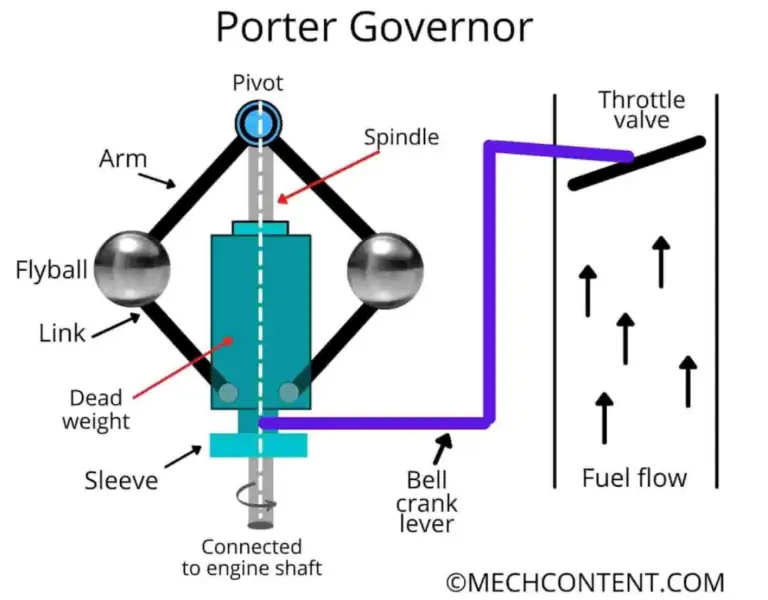A governor is a device which used in an engine to maintain the mean speed of the engine by controlling the flow of fuel with respect to load on the engine.
It means that, if the load on the engine increases then it requires more fuel to supply & in another case when the load on the engine decreases, then it requires less amount of fuel to be supplied.
In this article, we are discussing the porter governor in detail.
Contents:
What is a Porter governor?
Porter governor is a type of centrifugal governor with a dead weight attached onto the sleeve.
The porter governor is basically invented to overcome the disadvantage of the watt governor, since the watt governor is not suitable for high-speed engines. In watt governor, it becomes difficult to adjust the fuel supply at a higher speed.
Because of the dead weight attached to the sleeve, the flyball requires more effort to lift the sleeve. Hence, after reaching the required engine speed, the sleeve starts to slide onto the spindle.

Hence, due to the presence of dead weight, porter governor can control fuel flow at high speed while watt governor can’t control fuel supply at high speed.
The porter governor is invented by Charles T. Porter in 1858 to control the speed of the steam engines.
Construction:
The porter governor consists of the following components:
1] Arms & links: The upper end of the arm is pivoted to the spindle, and the lower end is connected to the flyball.
One end of the link is connected to the flyball & another end of the link is pivoted to the sleeve.
2] Flyballs: The flyballs are connected between arms & links. The flyballs revolve around the spindle.
When the spindle starts to rotate, the flyballs are pushed outward because of centrifugal force, which results in the movement of the sleeve over the spindle of the governor.
3] Dead weight :- This is the main component of this governor which makes it different from other governors.
The deadweight exerts extra force onto the sleeve. Hence, the sleeve is not easily lifted at lower RPM. When the speed of the engine reaches the desired level, the sleeve starts to move on the spindle.
Porter governor working:
Let’s discuss, how this governor works when the load on the engine increases and decreases.
Case-I: When load on engine increases
When load on the engine increases, the speed of the engine decreases.
Because of the decrease in rotational speed, the centrifugal force on flyballs decreases and flyballs moves inwards.
The radius of rotation of flyballs decreases and the sleeve moves in a downward direction.
The movement of the sleeve is used to operate the opening of the throttle valve by means of the bell crank lever.
As the sleeve moves downwards, the opening of the throttle valve increases, and the excess fuel is supplied to the engine.
Case-II:- When load on engine decreases
When the load on the engine decreases, the speed of the engine increases.
Because of the increase in rotational speed, the centrifugal force on flyball increases and flyballs are pushed outwards.
Thus, the radius of rotation of flyball increases and the sleeve moves in an upward direction.
As the sleeve moves upwards, the throttle valve opening is decreases and the supply of excess fuel is lowered.
Advantages and application:
Porter governor can work at higher RPM due to dead weight attached on the sleeve, which is its main advantage.
Application of the porter governor is found in the earlier steam engine to control the speed as per load by controlling the fuel flow.
FAQ’s:-
-
How does a porter governor differ from a Watt governor?
As compared to watt governor, porter governor consists of dead weight, which helps porter governor to control fuel flow even at high speed.
-
What is the use of Porter governor?
It is used for engine to maintain mean speed of the engine by controlling flow of fuel with respect to load on the engine.
It was also used in earlier steam engine to control the speed as per load by controlling the fuel flow.
Read also:
very nice and clear information.